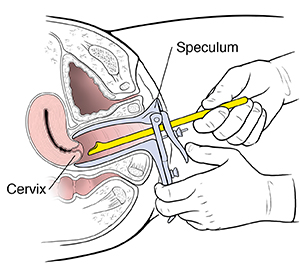A
B
C
D
E
F
G
H
I
J
K
L
M
N
O
P
Q
R
S
T
U
V
W
X
Y
Z
Topic IndexLibrary Index
Click a letter to see a list of conditions beginning with that letter.
Click 'Topic Index' to return to the index for the current topic.
Click 'Library Index' to return to the listing of all topics.
Pap Test
Schedule your test for a time when you will not be having your menstrual period. If you’re menstruating at the time of your appointment, call your health care provider to ask if you should reschedule.
For 48 hours before the test
For 24 hours before the test
How the test is done
-
You empty your bladder before the test.
-
You lie on an exam table with your feet in stirrups (footrests). This is the usual position for a pelvic exam (an exam of the reproductive organs).
-
Your health care provider uses a speculum (a metal or plastic instrument) to gently open the vagina.
-
Cells are taken from the cervix with a small spatula or rubber broom. A small brush may then be used to remove cells from inside the cervical canal. You may feel pressure or slight discomfort.
 |
| A speculum is used to open the vagina so cells can be taken from the cervix. |
Preserving the sample
There are two ways to preserve the sample after it is taken:
-
Traditional preservation. With this method, the sample is smeared directly onto a glass microscope slide. The sample is then sent to a lab to be analyzed.
-
Liquid-based preservation. The sample is placed in a special preservative solution. At the lab, cervical cells are separated from blood and mucous cells and spread onto a slide. Screening for human papillomavirus (HPV) can also be done using the same sample.
After the test
You’re free to go! There is a slight chance of light bleeding or spotting. Your health care provider will tell you when to expect your test results.
Getting your results
Ask your health care provider how you will receive your results. You should always obtain and understand results of any testing you have done. These may be obtained by phone, mail, or through online access if available:
-
Normal result. The cells in the sample appear healthy. Have your next Pap test as recommended by your provider.
-
Abnormal result. The lab saw something unusual in your sample. Talk with your provider about what the results mean. You may need to repeat the Pap test or have other tests to evaluate the problem.
Online Medical Reviewer:
Daphne Pierce-Smith RN MSN
Online Medical Reviewer:
Tennille Dozier RN BSN RDMS
Online Medical Reviewer:
Vinita Wadhawan Researcher
Date Last Reviewed:
1/1/2025
© 2000-2025 The StayWell Company, LLC. All rights reserved. This information is not intended as a substitute for professional medical care. Always follow your healthcare professional's instructions.